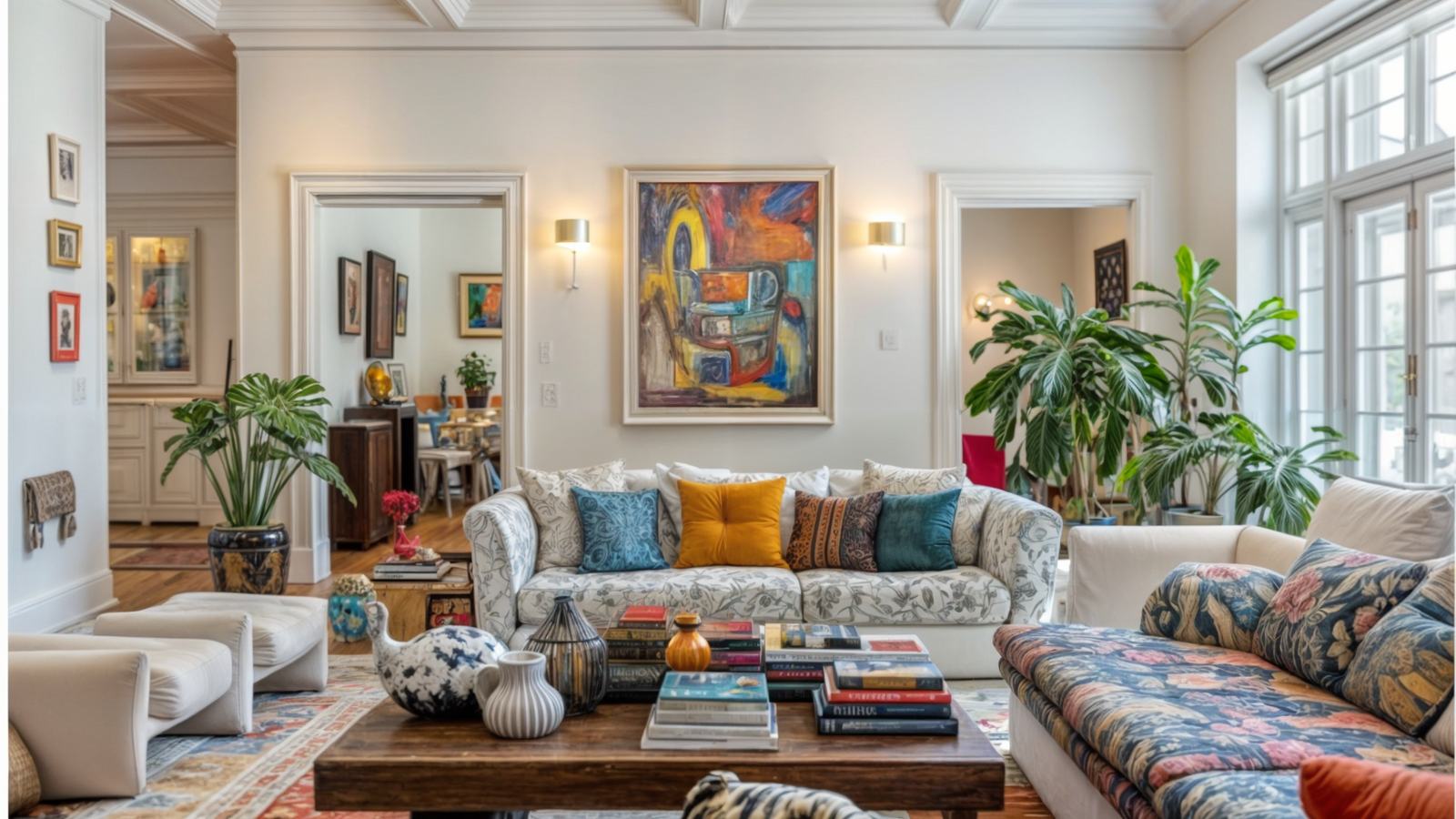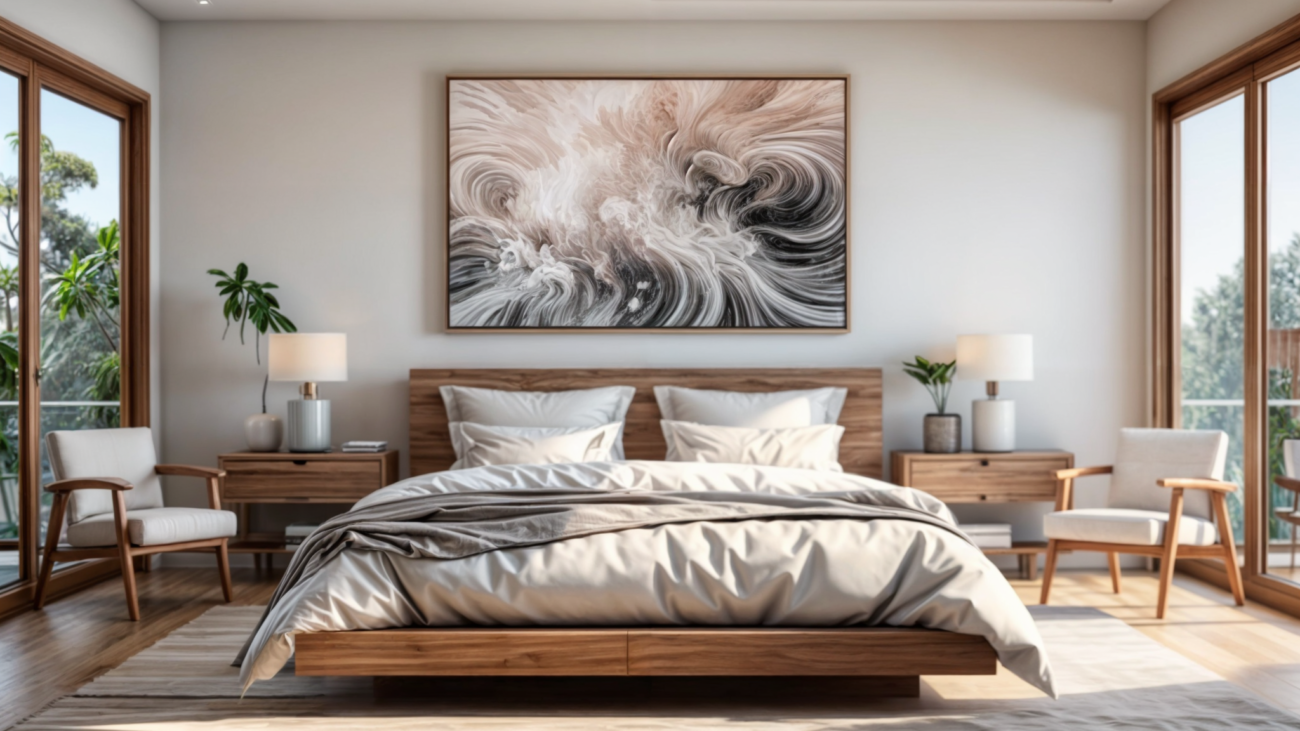The art of decor accents in modern homes encompasses several key elements that work together to create sophisticated and inviting spaces:
- Indoor Plants: Natural elements that bring life, purify air, and add organic beauty to spaces through strategic placement and thoughtful selection
- Abstract Art: Bold statement pieces that create visual interest and emotional depth while complementing modern design aesthetics
- Sculptural Lighting: Functional art pieces that combine illumination with artistic expression, creating dramatic focal points
- Ceramic Elements: Versatile pieces that bridge organic beauty with contemporary design through form and function
- Woven Elements: Textural components that add warmth and depth while providing both aesthetic appeal and practical functionality
- Minimalist Decor: Carefully curated pieces that embrace simplicity and purposeful design through quality over quantity
Each element plays a vital role in creating a cohesive, modern living space that balances aesthetics with functionality while reflecting personal style and contemporary design principles.
Transforming Your Modern Home with Indoor Plants: A Natural Touch of Life
In today’s modern interiors, indoor plants have transcended their traditional role as mere decorative elements – they have become indispensable features that infuse our living spaces with vibrant energy, natural beauty, and a sense of organic connection. These green companions serve as living artwork, breathing life into our carefully curated environments. Let’s delve into the artful integration of these natural elements into your home’s design.
Choosing the Right Plants
When curating a collection of plants for your modern home, carefully consider these essential categories that will help create a harmonious and sustainable indoor garden:
- Low-maintenance varieties perfect for busy homeowners, such as snake plants, ZZ plants, and pothos, which thrive with minimal attention while maintaining their aesthetic appeal
- Statement plants that create dramatic visual impact through their impressive size, unique foliage patterns, or architectural forms, becoming natural focal points in your space
- Air-purifying species that contribute to a healthier indoor environment by naturally filtering common household pollutants and improving overall air quality
Strategic Placement
The thoughtful positioning of indoor plants is a crucial aspect of biophilic design that can transform your space. Consider these refined placement strategies to maximize their visual and functional impact:
- Design eye-catching focal points in key areas of your home by creating layered plant compositions that draw the eye and enhance the room’s natural flow
- Create stunning vertical gardens to maximize space utilization while adding a dramatic living wall element that serves as both art and air purifier
- Style your shelves with thoughtfully arranged plants of varying heights, textures, and leaf shapes to create dynamic visual interest throughout your space
Remember that indoor plants serve multiple purposes in your modern home: they enhance the aesthetic appeal through their natural beauty, forge a strong connection to the outdoor environment, actively improve air quality through natural filtration, and contribute to a more peaceful and harmonious living environment by bringing the calming presence of nature indoors.

Abstract Art: Making Bold Statements in Modern Home Design
Abstract art has evolved into an essential element of modern interior design, serving as a powerful medium for personal expression and visual storytelling. More than just decorative pieces, abstract artworks have the unique ability to transform spaces, evoke deep emotional responses, and create lasting impressions. When thoughtfully incorporating abstract pieces into your home environment, there are two fundamental aspects that deserve careful attention and consideration.
Selecting the Perfect Piece
The selection process requires a nuanced understanding of several key elements that will ensure your chosen artwork enhances your space:
- Choose pieces that complement your space’s color scheme through thoughtful color coordination, considering both dominant and accent colors to create a harmonious visual flow throughout the room
- Consider the scale and proportion of the artwork in relation to your wall space and room size, ensuring the piece commands attention without overwhelming the space or getting lost in it
- Explore mixed media options to add depth and texture to your decor, incorporating pieces that combine different materials, techniques, and dimensional elements to create rich, layered visual experiences
Mastering Display Techniques
The presentation of your abstract art can significantly influence its impact on your space:
- Create dynamic gallery walls that tell a visual story, carefully arranging multiple pieces to form a cohesive narrative while maintaining visual balance and flow
- Use statement pieces as focal points in key areas, positioning them strategically to draw the eye and anchor the room’s design scheme
- Implement art rotation systems to keep your space fresh and engaging, periodically changing artwork positions or introducing new pieces to maintain visual interest and prevent design stagnation
Remember, abstract art isn’t just about filling wall space—it’s about creating meaningful conversations, stirring emotions, and adding sophisticated depth to your modern home aesthetic. Each piece should contribute to the overall atmosphere while reflecting your personal artistic sensibilities and design vision.

Sculptural Lighting: Illuminating with Style
Sculptural lighting has revolutionized modern home design, transforming ordinary fixtures into captivating works of functional art that command attention and define spaces. These innovative lighting solutions merge the boundaries between illumination and artistic expression, creating an entirely new category of design elements that elevate the aesthetic of any room. Let’s explore how to masterfully incorporate these elegant pieces into your space:
Statement Lighting Options
The foundation of sculptural lighting lies in its diverse and expressive forms, each offering unique opportunities for artistic expression:
- Pendant lights – perfect for creating dramatic focal points in dining areas or entryways, these suspended pieces can range from delicate crystalline formations to bold geometric structures that capture both light and imagination
- Floor lamps – versatile pieces that add both function and artistic flair, serving as free-standing sculptures that transform empty corners into curated gallery spaces while providing essential illumination
- Wall sconces – architectural elements that combine illumination with visual interest, creating dynamic plays of light and shadow that add depth and dimension to your walls
Strategic Placement and Purpose
The true artistry of sculptural lighting emerges through thoughtful placement and intentional design choices:
- Ambiance Creation – Using light to set the perfect mood for each space, considering how different intensities and directions of light can create varying atmospheres throughout the day and night
- Functional Illumination – Balancing artistic expression with practical lighting needs, ensuring that each fixture serves both as a stunning visual element and an effective source of light for daily activities
- Artistic Statement – Treating lighting fixtures as sculptural art pieces that enhance your décor, carefully considering how each piece interacts with surrounding elements and contributes to the overall design narrative
Remember to consider your overall design aesthetic when selecting sculptural lighting. The most successful pieces will not only complement your existing decor but will also serve as conversation starters, creating memorable focal points that elevate your space from simply well-lit to truly extraordinary. The key lies in finding pieces that strike the perfect balance between bold artistic expression and refined functionality, ensuring they make a confident statement while seamlessly integrating into your home’s design story.
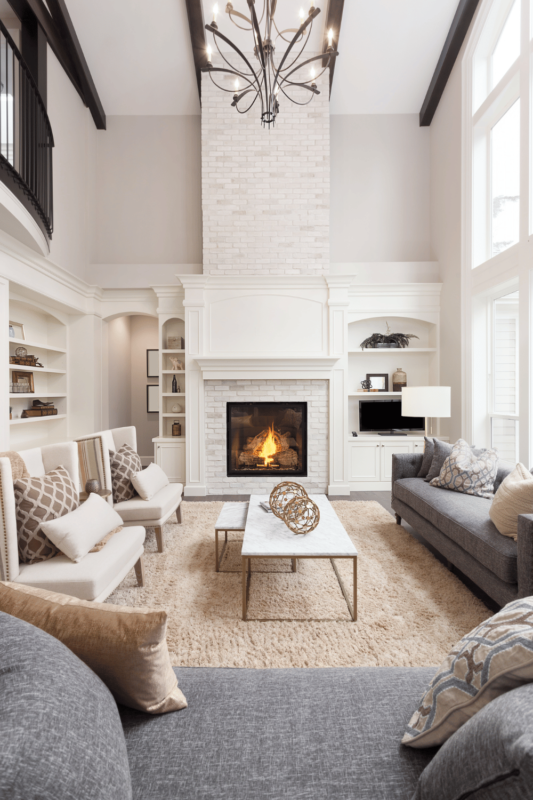
Ceramic Elements: The Perfect Blend of Form and Function in Modern Homes
In the realm of modern interior design, ceramic elements masterfully bridge the gap between organic beauty and contemporary aesthetics. These versatile and timeless pieces possess the unique ability to transform any space, infusing it with natural charm while maintaining a sophisticated and refined edge that perfectly complements modern design sensibilities. The tactile nature of ceramics brings an element of handcrafted authenticity to even the most contemporary spaces, creating a perfect balance between warmth and modernity.
Diverse Forms of Ceramic Expression
The expansive world of ceramic decor presents a rich array of options to enhance and elevate your living space:
- Elegant vases and vessels that serve as standalone artistic statements, each piece telling its own story through form, texture, and craftsmanship
- Decorative objects that add personality and visual interest to shelves and surfaces, becoming conversation pieces that reflect both artistic vision and personal style
- Functional pieces that seamlessly combine practicality with beauty, proving that everyday items can be both useful and aesthetically pleasing
The Art of Styling with Ceramics
To fully realize the transformative potential of ceramic elements in your space, consider these essential styling principles:
- Thoughtful color coordination to create harmony with your existing decor, paying special attention to both dominant tones and subtle undertones that can tie a room together
- Strategic grouping techniques to create visually appealing arrangements, considering height variations, negative space, and visual weight to achieve perfect balance
- Incorporation of mixed materials to add depth and interest to your displays, combining ceramics with complementary elements like wood, metal, or glass for rich textural contrast
Whether you’re drawn to minimalist design principles or embrace an eclectic aesthetic, ceramic elements prove to be incredibly versatile additions to any modern home. Their ability to bring warmth, texture, and organic beauty to a space while maintaining a contemporary edge makes them indispensable in creating sophisticated, lived-in environments that feel both curated and comfortable.
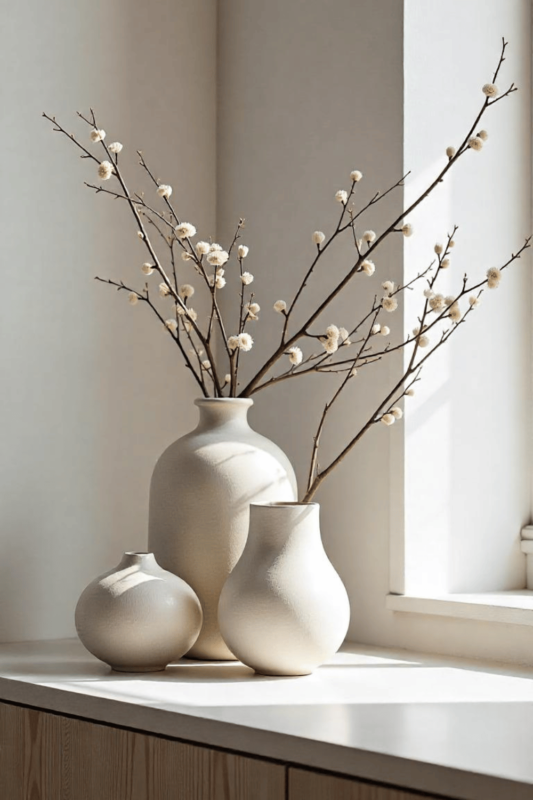
Woven Elements: Adding Texture and Warmth to Modern Spaces
In the contemporary landscape of modern home design, woven elements have emerged as indispensable components that masterfully combine both practical functionality and sophisticated aesthetic appeal. These remarkably versatile pieces serve multiple purposes: they introduce rich textural dimensions, create visual depth through natural materials, and infuse spaces with an organic warmth that perfectly complements contemporary interiors. The artisanal nature of woven elements adds an authentic, handcrafted quality that softens the clean lines and minimal aesthetics often found in modern spaces.
Types of Woven Decor
The remarkable versatility of woven elements manifests through an array of sophisticated forms, each bringing its unique character to modern interiors:
- Storage baskets that seamlessly merge practical organization with refined style, featuring natural materials and intricate weaving patterns that elevate everyday storage solutions into decorative statements
- Artistic wall hangings that transform vertical spaces into captivating focal points, incorporating complex textures and dimensional elements that add depth and visual intrigue to any room
- Decorative objects that introduce personality and artisanal charm, ranging from handwoven bowls to sculptural pieces that serve as sophisticated conversation starters
Strategic Integration
To fully realize the transformative potential of woven elements in your home, consider these comprehensive approaches:
- Implement thoughtfully designed storage solutions that harmoniously blend with your existing decor, utilizing natural materials and traditional weaving techniques to create functional pieces that enhance rather than detract from your space
- Create carefully curated artistic displays that serve as compelling focal points, combining different scales, textures, and weaving patterns to develop visually dynamic compositions that draw the eye and engage the senses
- Use strategically placed woven pieces to introduce sophisticated textural contrast in modern spaces, playing with the interplay between smooth and textured surfaces to create rich, layered environments
Through the mindful incorporation of these carefully selected woven elements, you can craft a beautifully balanced interior that successfully marries sophisticated contemporary design with inviting warmth. This thoughtful integration creates spaces that feel both refined and welcoming, effectively bridging the gap between sleek modern aesthetics and the natural comfort that woven elements inherently provide.
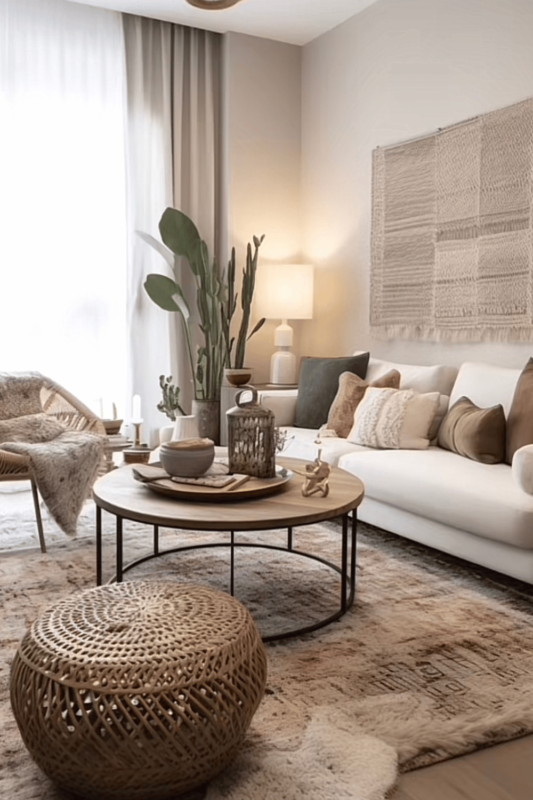
Minimalist Decor: The Art of Restraint – A Guide to Elegant Simplicity
In the realm of interior design, minimalist decor represents a profound embodiment of the timeless philosophy that less truly is more. This sophisticated approach to design celebrates the beauty of simplicity while demanding meticulous attention to detail. At its foundation, minimalist decorating is guided by three essential and interconnected principles that work in harmony to create spaces of exceptional clarity and purpose:
Quality Over Quantity
The essence of minimalist design lies in the careful selection of fewer, but significantly higher-quality pieces that seamlessly integrate both function and form. Each carefully chosen item must justify its presence through both its practical utility and its aesthetic contribution to the space. This deliberate approach to selection ensures that every element holds both purpose and beauty, creating an environment where quality speaks louder than quantity.
Embracing Negative Space
Negative space transcends the concept of emptiness – it stands as a powerful and intentional design element that creates essential breathing room and cultivates visual tranquility. This thoughtful incorporation of space serves multiple purposes: it prevents visual overwhelm, allows each carefully selected piece to command appropriate attention, and creates a sense of calm that permeates the entire environment. The strategic use of negative space becomes a design element in itself, contributing to the overall composition and balance of the room.
Purposeful Selection
Every single element within a minimalist space must be chosen with careful consideration and clear intention. This thoughtful curation process ensures that each component not only serves its individual purpose but also contributes meaningfully to the collective design narrative. The result is a space where nothing feels superfluous or out of place, and every item plays a vital role in the overall composition.
Implementing Minimalist Design
To successfully embrace and implement minimalist decor, consider these essential and comprehensive strategies:
- Begin with a thorough decluttering process to eliminate unnecessary items and establish a clean, clear foundation for your design vision
- Develop and maintain a carefully coordinated color palette that promotes visual harmony and creates a sense of cohesion throughout the space
- Focus on achieving perfect balance in every aspect of your design, from furniture placement to accessory arrangement
Remember that minimalist decor isn’t about creating austere or impersonal spaces – rather, it’s about thoughtfully curating your environment to achieve maximum visual and emotional impact through carefully selected elements. This approach celebrates the beauty of restraint while creating spaces that feel both sophisticated and deeply intentional.
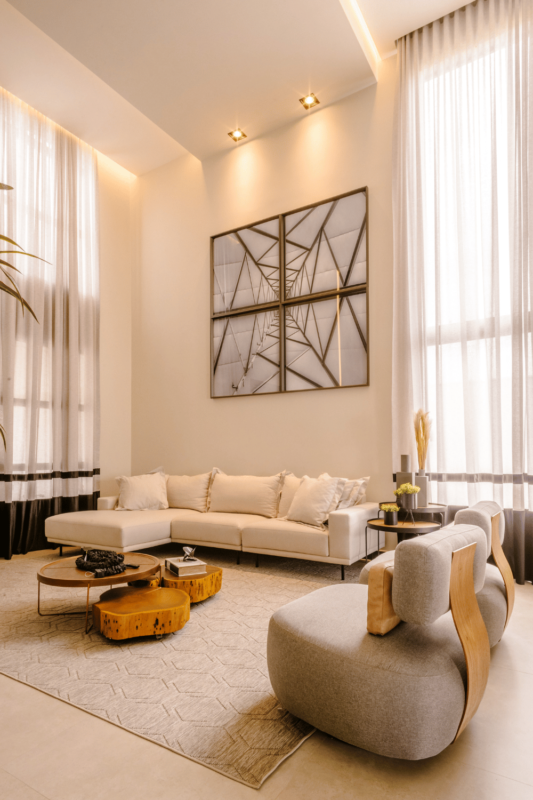
Conclusion
Modern home design is an artful blend of aesthetics and functionality, where every element plays a crucial role in creating harmonious living spaces. From the life-giving presence of indoor plants to the bold statements of abstract art, from the dramatic impact of sculptural lighting to the organic beauty of ceramics, each design element contributes to a cohesive and inviting atmosphere.
The key to successful modern home design lies in thoughtful curation and balanced integration. Whether you’re embracing minimalist principles or incorporating woven textures, the goal remains the same: creating spaces that reflect personal style while maintaining functionality. By carefully selecting and positioning each element, you can transform your home into a sanctuary that embodies contemporary elegance while remaining wonderfully livable.
Remember that modern home design is not about following trends blindly, but rather about creating spaces that resonate with your lifestyle while maintaining a timeless appeal. As you implement these design principles, let your personal taste guide you in crafting a home that’s both sophisticated and welcoming – a true reflection of modern living at its finest.
Frequently Asked Questions (FAQ)
- What are decor accents?
Decor accents are decorative items and features that enhance the aesthetic appeal of a space, such as cushions, wall art, vases, and rugs. - Why are decor accents important in modern home design?
Decor accents personalize a space, add texture and depth, and reflect the homeowner’s style while making a house feel like a home. - What are decorative accents and why are they significant in modern homes?
Decorative accents are embellishments that enhance the aesthetic charm of a space. They add personality, style, and uniqueness to modern homes, fostering a more inviting and visually appealing atmosphere. - How can I choose the right decorative accents for my area?
Consider your home’s color scheme, existing furniture styles, and your personal tastes. Select accents that complement these elements while also reflecting your distinctive visual style - What types of decor accents are considered modern?
Modern decor accents often feature clean lines, minimalist designs, and use materials such as metal, glass, and natural wood to create a sleek aesthetic.
>> Learn more: Why are Color Schemes Important in Interior Design?


